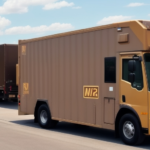Understanding UPS Air Shipping Rates
If your business relies on shipping items nationally or internationally, comprehending the associated costs is crucial. UPS Air Shipping is a popular choice for many due to its reliability and speed. This article delves into the intricacies of UPS Air Shipping rates, the factors influencing these rates, and offers actionable tips to help you save on shipping costs.
Why Air Shipping is Important for Businesses
The surge in e-commerce and the demand for rapid delivery have elevated the significance of air shipping in modern logistics strategies. UPS Air Shipping stands out by offering swift and dependable services, with delivery times ranging from same-day to three days.
Beyond speed, air shipping enables businesses to reach customers in remote or hard-to-access regions. This capability is vital for companies dealing with perishable goods or time-sensitive products, such as medical supplies or electronics. Additionally, air shipping provides enhanced flexibility in supply chain management, allowing businesses to swiftly adapt to fluctuating demands or unforeseen disruptions in shipping routes.
According to the Statista 2023 report, global e-commerce sales are projected to exceed $6.3 trillion by 2024, underscoring the critical role of efficient shipping solutions like UPS Air Shipping.
How UPS Calculates Air Shipping Rates
UPS determines air shipping rates based on several key factors:
- Package Weight: Heavier packages incur higher shipping costs.
- Distance: The greater the distance between origin and destination, the higher the rate.
- Service Type: Options like next-day or two-day air affect the overall cost.
- Package Dimensions: Larger packages typically cost more to ship.
- Fuel Costs: Fluctuations in fuel prices are reflected in shipping rates.
- Operational Expenses: Costs related to handling, logistics, and other operational aspects.
UPS also considers any special handling requirements, such as shipping hazardous materials or fragile items, which may necessitate additional fees. Seasonal variations, particularly peak shipping seasons like holidays, can lead to higher rates due to increased demand. UPS provides tools and resources on their website to help businesses estimate shipping costs and select the most economical options.
For the latest insights and detailed rate calculations, refer to the UPS Rate Guide 2023.
Factors that Affect UPS Air Shipping Rates
Beyond the primary factors, several additional elements can influence UPS Air Shipping rates:
- Seasonal Demand: Shipping during peak seasons or weekends may result in higher rates.
- Packaging Type: UPS offers discounts for using their branded packaging materials.
- Destination Specifics: Shipping to remote or rural areas can incur higher fees due to increased transportation efforts.
- Service Speed: Opting for faster delivery options, such as next-day air, typically costs more.
- Volume Discounts: Businesses shipping large volumes may qualify for discounted rates.
To optimize shipping costs, consider consolidating multiple packages into single shipments and leveraging UPS promotions or discounts tailored for businesses and non-profit organizations.
Comparison of UPS Air Shipping vs. Other Carriers
When evaluating shipping options, it's essential to compare UPS Air Shipping with other carriers like FedEx and USPS to determine the best fit for your needs.
Speed of Delivery: UPS offers a variety of air shipping options, including Next Day Air, 2nd Day Air, and 3 Day Select. Depending on the urgency, one of these may be more appropriate compared to other carriers' standard services.
Customer Service: UPS is renowned for its excellent customer service, providing dedicated support teams to address queries and resolve issues promptly. This level of support is especially valuable for time-sensitive shipments or when unexpected delays occur.
For a comprehensive comparison, refer to the Shipping Comparison 2023 for detailed insights.
Tips to Save Money on UPS Air Shipping Rates
Businesses can employ several strategies to reduce UPS Air Shipping costs:
- Choose Slower Delivery Times: Opting for three-day delivery instead of two-day can lower shipping expenses.
- Use UPS Packaging: Utilizing UPS-branded packaging may qualify for discounts.
- Consolidate Shipments: Combining multiple packages into a single shipment can reduce overall costs.
- Negotiate Rates: If your business ships a significant volume, negotiating directly with UPS for better rates is advisable.
- Optimize Package Size and Weight: Efficient packaging can prevent additional fees for oversized or overweight items.
Leveraging these strategies can lead to substantial savings. For more detailed saving tips, visit the Money Saving Tips on ShipScience.
Understanding UPS Air Freight Charges
For larger shipments exceeding 150 pounds, UPS offers air freight services. Charges are determined based on:
- Weight and Dimensions: Larger and heavier shipments incur higher fees.
- Distance: The origin and destination points influence the cost.
- Accessorial Services: Additional services like liftgate or inside delivery add to the total cost.
Shipping hazardous materials necessitates special handling and may involve extra charges. UPS provides various air freight service levels, such as Next Flight Out or Second Day Air Freight, each with different pricing structures. Consulting with a UPS representative can help identify the most cost-effective and efficient air freight option tailored to your shipment needs.
For more information, visit the UPS Air Freight Services page.
Types of UPS Air Shipping Services Available
UPS offers a diverse range of air shipping services to accommodate various business requirements:
- Next Day Air: Guarantees delivery by the next business day.
- 2nd Day Air: Ensures delivery within two business days.
- 3 Day Select: Offers delivery within three business days.
- International Express: Provides expedited international shipping options.
Additionally, UPS offers guaranteed service options, such as money-back guarantees for late deliveries, enhancing reliability for time-sensitive shipments.
For specialized needs, UPS provides:
- Temperature-Controlled Air Shipping: Ideal for perishable items requiring specific temperature conditions.
- Dangerous Goods Air Shipping: Tailored for hazardous materials necessitating stringent safety measures.
To manage air shipping efficiently, UPS offers tools like online tracking, customizable shipping options, and packaging solutions. Explore more at the UPS Services section.
How to Choose the Right UPS Air Shipping Service for Your Needs
Selecting the appropriate UPS air shipping service involves evaluating several factors:
- Package Weight: Heavier packages may necessitate more robust shipping options.
- Delivery Time: Urgent shipments may require next-day or two-day air services.
- Destination: Ensure the chosen service covers the intended delivery location.
- Budget: Compare costs across different services to align with your budget constraints.
- Tracking and Insurance: Opt for services that offer comprehensive tracking and adequate insurance coverage.
It's also essential to review the service's coverage map to confirm delivery feasibility. For a detailed guide on selecting the right service, refer to the Choosing the Right UPS Service article.
Understanding the Different Zones for UPS Air Shipments
UPS categorizes the United States into various zones for air shipping, with rates increasing as the destination zone moves further from the origin. Understanding zone distances is critical for accurate shipping cost calculations.
International shipments are also divided into zones based on destination countries, determined by factors like distance, customs regulations, and transportation infrastructure. Familiarizing yourself with the shipment's zone can help predict shipping costs and delivery times.
For detailed zone information, visit the UPS Shipping Zones page.
How to Track Your UPS Air Shipment
UPS provides comprehensive online tracking for air shipments, enabling businesses to monitor package progress and receive real-time delivery updates. Tracking details include origin and destination points, current delivery status, and any potential delays or issues.
Additionally, UPS offers a mobile app for tracking on-the-go. The app sends push notifications for delivery updates and allows users to schedule delivery changes or pickups. Available for both iOS and Android, the UPS Mobile App can be downloaded for free from the App Store and Google Play.
For more tracking options, visit the UPS Tracking page.
Common Mistakes to Avoid When Using UPS Air Shipping Services
While UPS Air Shipping is a reliable choice, certain pitfalls can undermine its effectiveness:
- Poor Packaging: Inadequately packaged items are prone to damage during transit.
- Incorrect Shipping Information: Errors in addresses or contact details can lead to delivery issues.
- Ignoring Potential Delays: Failing to account for possible delays can disrupt business operations.
- Overlooking Costs: Not comparing shipping options or ignoring available discounts can result in higher expenses.
- Neglecting to Use Available Discounts: Not leveraging UPS's volume discounts or promotional offers can lead to unnecessary costs.
To avoid these mistakes, ensure accurate packaging, double-check shipping information, plan for potential delays, and take advantage of UPS's cost-saving opportunities. For more insights, refer to the Common Shipping Mistakes guide.
Benefits and Drawbacks of Using UPS Air Shipping
UPS Air Shipping offers several advantages:
- Speed: Fast delivery times meet the demands of time-sensitive shipments.
- Reliability: Consistent service with excellent tracking and customer support.
- Global Reach: Ability to ship to a wide range of international destinations.
However, there are also potential drawbacks:
- Higher Costs: Air shipping is generally more expensive than ground shipping.
- Environmental Impact: Air shipping has a larger carbon footprint compared to other methods.
- Size and Weight Limitations: Restrictions on package dimensions and weight can limit shipping options.
Balancing these benefits and drawbacks is essential for optimizing your shipping strategy. For more detailed analysis, explore the UPS Shipping Benefits and Drawbacks section.
Understanding the Role of Insurance in UPS Air Shipments
UPS provides shipment insurance for air shipping services, ensuring coverage for the package's value in case of damage or loss during transit. When deciding whether to purchase insurance, consider the package's value and fragility:
- Standard Coverage: Packages valued at $100 or less are automatically covered by UPS's liability coverage.
- Additional Coverage: For packages exceeding $100, additional insurance can be purchased to cover the full value.
It's vital to review the terms and conditions of UPS's insurance policies to ensure adequate coverage for your shipments. For more information, visit the UPS Insurance Coverage page.
In summary, understanding UPS Air Shipping rates and services is essential for any business dependent on shipping operations. By evaluating factors such as package weight, delivery time, and packaging options, businesses can refine their shipping strategies to enhance efficiency and reduce costs.






















